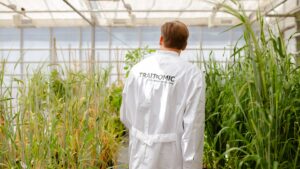EVERY DAY, PLANT BREEDERS HELP TO ENSURE BIODIVERSITY AND FOOD SECURITY.
Mutation is the source of all life. Without mutation, mankind would not exist. Starting from the first unicellular organism, mutation has created all the different plant and animal species and within each of those species a lot of diversity, which — in addition to food security — if the theme of this issue of European Seed. Plant breeders use this diversity to create all those wonderful new plant varieties that we so desperately need to provide sufficient and nutritious food for all. In real estate, ‘location’ is everything – in plant breeding its ‘diversity’ that is key.
Without diversity there can be no plant breeding. Plant breeding is the art and science of changing the traits of plants to produce desired characteristics, beneficial to mankind. And this is accomplished with the help of many different techniques ranging from simply selecting plants with desirable characteristics for propagation, to more complex molecular techniques. But in order to select something that is better than what was there diversity is necessary. So, plant breeders use and create diversity on an ongoing basis.
They do this mainly by crossing plants and subsequently selecting among the offspring, and often with the help of a whole range of different techniques, such as inducing mutations and introducing different genetic traits through special techniques. Plant breeders have to cope with a great diversity of genetic characters determining yield, quality and a whole number of other breeding targets of the crop. Making the right choices is absolutely critical as with an increasing number of traits to select for, the time and plant material that is required also increases.
At the same time, with increasing traits, the response to selection is likely to decrease. And it does not end there. Within many crops there are different uses. A potato variety that is perfect for french fries, may not be suitable for chips production, and a wheat variety that is perfect for making bread may not be suitable for pastry. So the plant breeder has to keep many different quality objectives in mind. Once the variation is created, the plant breeder is then confronted with a wide array of diversity, and has the challenge to select the right plants with which to continue within each of the different breeding programs.
My professor of plant breeding used to say that “Plant breeding is the art of throwing away!’ For a plant breeder to decide what can be thrown away, a constant stream of information is needed about consumer preferences with the aim of identifying the relevant genetic traits, to quanti fy their economic importance and adjust breeding objectives if necessary.
Creating a new plant variety takes seven to 12 years, and in certain crops even longer than that. So the plant breeder has to make assumptions about what consumers will want 15 to 20 years from now. He will need to look into his crystal ball and predict what the consumer’s tastes and preferences will be by that time. However, such preferences vary due to changes in income, market supply of food products, information and technology. And these changes happen within a time scale that is far shorter that the creation time of a new variety. So a constant adjustment of breeding objectives during the course of a breeding program is necessary.
But back to diversity: only by creating sufficient diversity and selecting the right plants to go forward can plant breeders develop better seed for a better quality of life, bringing economic, environmental and health benefits. Plant varieties that are resistant to drought and disease guarantee harvest security by reducing the risk of crop failure and thus supporting sustainable agriculture and global food security. When we talk about food security, this is strongly linked to hunger. In Europe most people enjoy sufficient food that is safe, nutritious and affordable.
But this is not always the case in the rest of the world. To get a good impression just the global fight against hunger, just take a look at the Global Hunger Index (GHI). Each year, the International Food Policy Research Institute (IFPRI) calculates GHI scores in order to assess progress, or the lack thereof, in decreasing hunger. The GHI is designed to raise awareness and understanding of regional and country differences in the struggle against hunger. Those who have followed the development of global hunger of the past decades will have noticed that the level of hunger in developing countries as a group has fallen by 27 per cent since 2000. And whereas in 1990 there were still 17 countries in the ‘Extremely alarming’ category, this category had disappeared in 2015.
However, while the world has made progress in reducing hunger in recent decades, the state of hunger is still ‘serious’ or ‘alarming’ in 52 countries. IFPRI is one of the research centres of the CGIAR Consortium, a worldwide partnership engaged in agr icultural research and development. The Consortium has 15 research centers and many research programs. All the major global gene banks such as CIMMYT, IRRI, ICRISAT, ICARDA and CIP are all part of the CGIAR Consortium. And these are the genebanks that are so crucial in preserving the genetic diversity in crops.












